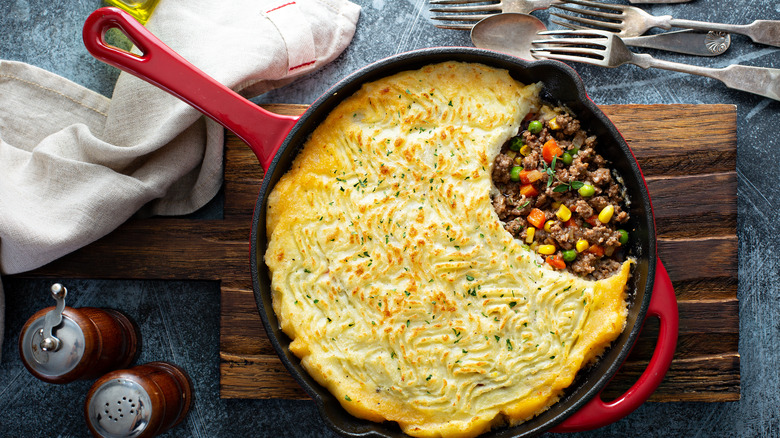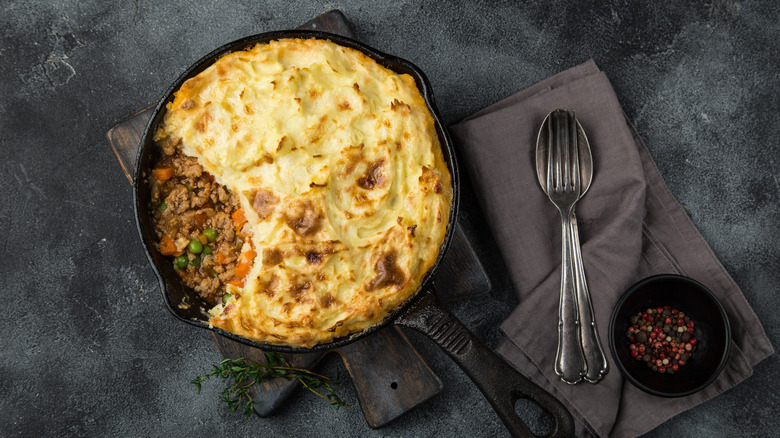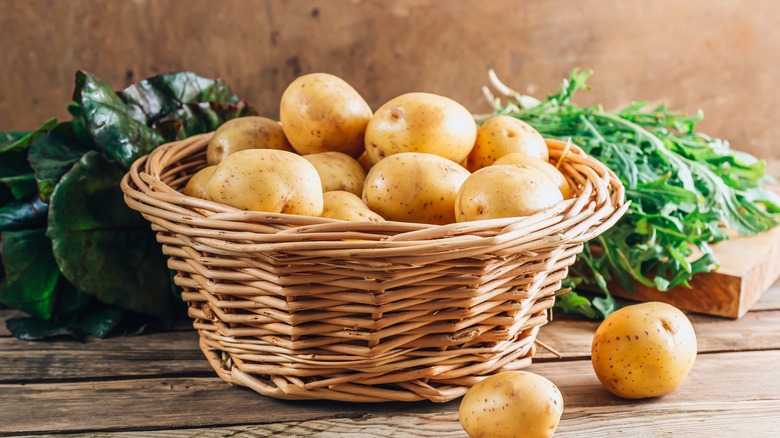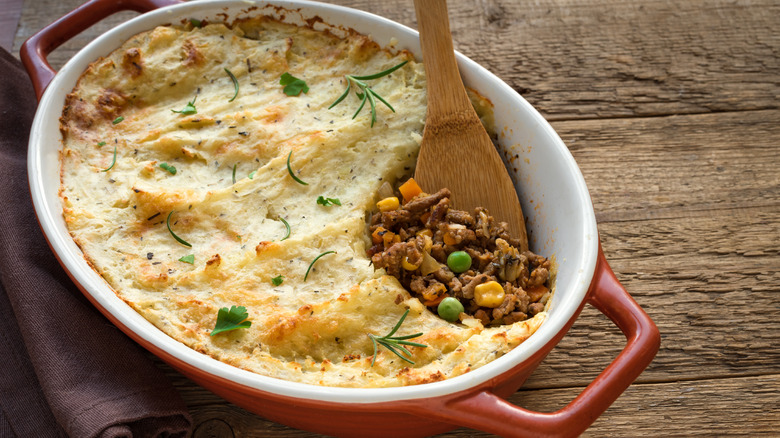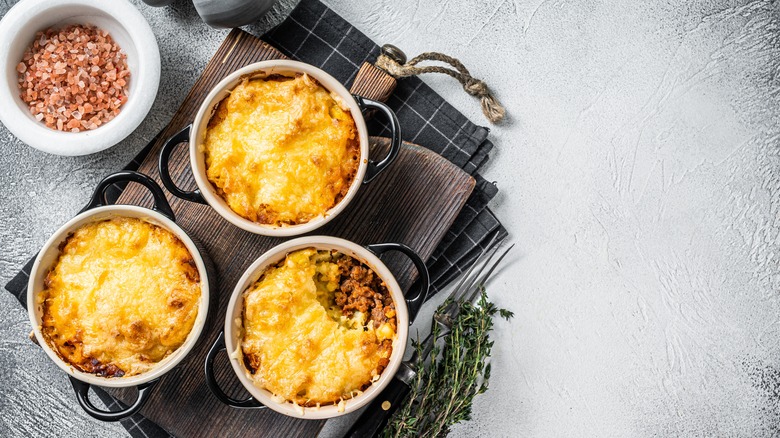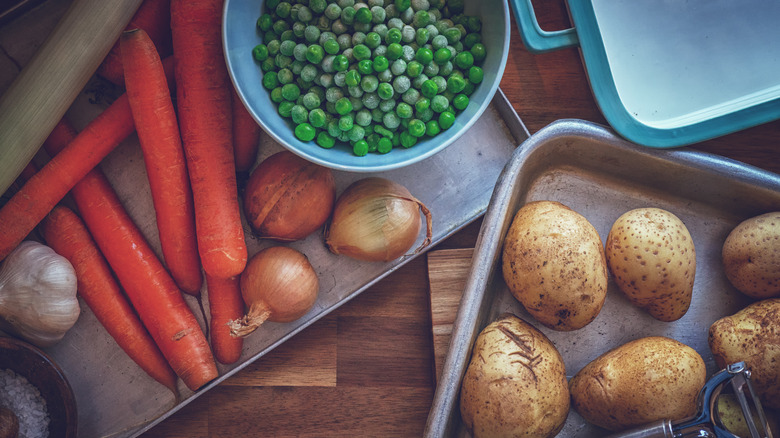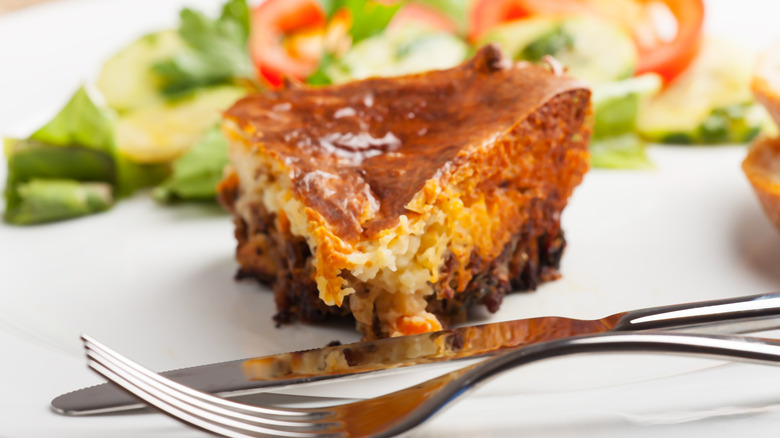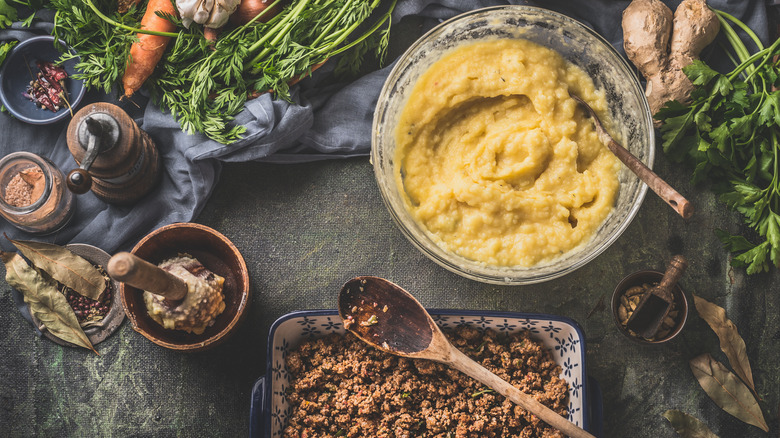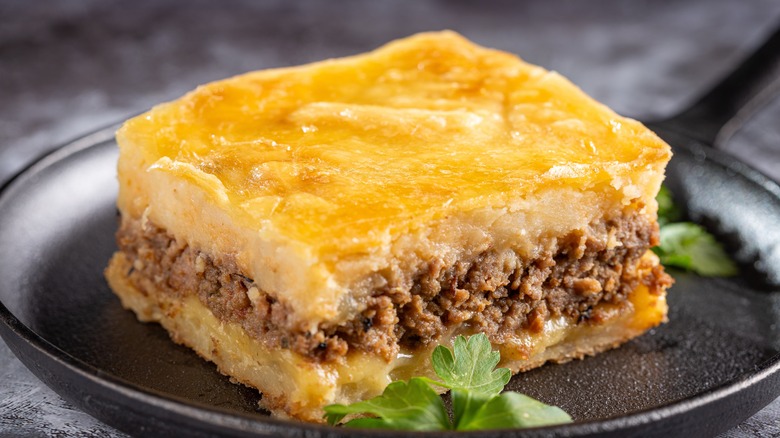The Complete History Of Shepherd's Pie
When it comes to warm and hearty dishes, shepherd's pie is one of those comfort food favorites that's perfect for cold nights. You may have your own fond memories of this classic family meal. Many of us grew up enjoying shepherd's pie fresh out of the oven as part of our weeknight or Sunday dinners.
So, what is it exactly? Shepherd's pie is a savory pie with a meat and vegetable filling, similar to chicken pot pie. But shepherd's pie uses ground lamb (and sometimes beef), not chicken. Shepherd's pie also has a mashed potato crust. Some versions of the recipe only have the mashed potato crust as a top layer, while others call for it on the bottom to encase the meat filling, but the mashed potatoes are a must for a true shepherd's pie.
Those are the basics of this dish. But there's a lot more to shepherd's pie than its ingredients can tell you. From politics to economics to agriculture, there are so many factors that went into creating shepherd's pie, and its history is as interesting as the classic dinner recipe is delicious. Shepherd's pie has been around long enough that its exact history is a little murky, but by looking through historical timelines of when ingredients would have been available, as well as cookbooks and written records from that period, we've got a pretty clear picture of how this recipe was created.
The shepherd's pie grew from Ireland's occupation
While it's hard to pinpoint exactly when and who first created shepherd's pie, it likely came about in the 1700s. However, that is not where the story of this recipe truly begins. When looking at the origins of our favorite foods, it's impossible to separate them from the culture and history that created those dishes. When it comes to shepherd's pie, the traditional family dinner has roots in Britain and Ireland. Still, it is primarily considered an Irish dish, and its history is wrapped up in the history of Ireland.
The groundwork for the creation and popularization of this recipe was laid centuries earlier. England and Ireland began building relations in the 12th century. England began to assert more control over Ireland's government, officially taking over in 1541. It's important to note that while Ireland had historically been a catholic nation, the British were protestant. As a result, Irish Catholics fell in the ranks of society beneath British and Irish protestants. This led to poverty and food shortages for Irish Catholic peasants. Because of this, affordable and filling meals were essential. Shepherd's pie was eventually created by the Irish working class to meet those exact needs (via Greatist).
The potato came to Ireland in the late 1500s
Along with the political background, having access to the ingredients is an essential piece to a recipe's creation. Shepherd's pie never would have come to be without one of its key ingredients, the potato. The mixture of meat, gravy, and vegetables wouldn't be nearly as satisfying without the mashed potato crust that completes the savory pie.
When we think of Irish and British cuisine, the potato is a component in many iconic dishes, but that wasn't always the case. It's hard to imagine a hearty Sunday roast or a St. Patrick's Day feast without a side of some type of prepared potatoe. So, it's interesting that the potato wasn't introduced to Europe until the 1500s.
The prevailing story is that Sir Walter Raleigh began planting potatoes on his estate after bringing them to Ireland from Virginia. However, History Ireland has pointed out some holes in this theory, chief amongst them that Raleigh never visited Virginia. It's far more likely the plant gradually gained popularity after being brought to Europe from South America, eventually making its way from England to Ireland. Potatoes then became an essential crop for the Irish because they were easy to grow, filling, and affordable.
The creation of the cottage pie
Shepherd's pie and cottage pie have more similarities than differences. In fact, the terms are often used interchangeably to refer to any dish consisting of ground meat and vegetables in gravy with a potato topping. But, if you want to be technical, the difference between the two is in the type of meat used. Cottage pie was traditionally made with ground beef (and occasionally other types of meat), while shepherd's pie is made with lamb.
Still, the dishes are very similar, to the point that today, many families make the recipe with ground beef and still call it a shepherd's pie. The two pies are so closely linked that shepherd's pie may never have been created without cottage pie. According to Greatist, the cottage pie, which was the precursor to shepherd's pie, began being served in British and Irish households during the 1700s. It was named "cottage pie," likely because it was a dish primarily made by the poor and working-class people who lived in cottages.
The working class couldn't afford beef
Shepherd's pie is more closely associated with Ireland than cottage pie, which preceded it. As mentioned, the main difference between these two dishes is that cottage pie uses ground beef, and shepherd's pie uses lamb. This is likely because, at the time the dish was being created, most working-class Irish could not afford beef. During the 17th century, there were plenty of cattle in Ireland because British landowners had moved cattle into Ireland, making the Irish well-known for exporting corned beef, a dish now heavily associated with the Irish holiday of St. Patrick's Day.
But, while the Irish workers farmed and exported the beef, they could not typically afford to eat cow meat themselves. Beef was considered a luxury. Lamb meat, on the other hand, was less expensive than beef, making it a more affordable option for most Irish families (via History Cooperative). This is also likely why lamb or mutton meat was used for Irish stew. Using mutton or lamb meat instead of beef also led to the Irish meat pie being named "shepherd's pie" after the shepherds who tend to sheep.
Shepherd's pie was used to avoid waste
The original idea behind making cottage and shepherd's pie was to use any leftover meat and vegetables from previous meals. Letting food go to waste is never good, and as many working-class families faced poverty and food shortages, it was important to make the most out of every scrap of food. At the time, it was unclear to many workers when their next meal would come. So, making another dish out of kitchen scraps and leftovers was not just frugal but essential.
According to Greatist, cottage and shepherd's pie was typically made with leftover meat from a previous night's dinner. Rather than throwing lamb or mutton scraps out, home cooks mixed the leftovers with whatever vegetables they had. Then came the ingenious addition of mashed potatoes. Because potatoes were an affordable and filling crop, adding a mashed potato crust to the leftovers was the perfect way to transform the kitchen scraps into an entirely new dish and make it perfectly satisfying to keep folks from going hungry.
The recipe was first referenced in writing in 1791
Tracing the exact origin of recipes can be quite tricky. And with old family dishes like shepherd's pie, there's no specific chef or restaurant that we can point to as the creator of the dish. The recipe was likely shared by word of mouth from family to family, with many variations on the dish throughout the years.
According to History Cooperative, the first written record we have of cottage pie came from a 1791 diary, but versions of cottage and shepherd's pie were undoubtedly baked and enjoyed by Irish and British families long before that. Reverend James Woodforde kept careful records of day-to-day life in his multi-volume diaries. In 1791, the reverend made an entry referencing eating "Cottage-Pye and rost Beef."
It would be a few more decades before anyone wrote about the lamb version of the dish. In her 1806 book, "New System of Domestic Cookery: Formed Upon Principles of Economy; and Adapted to the Use of Private Families," Maria Rundell refers to a recipe consisting of minced mutton (or beef) and mashed potatoes. But while this clearly appears to be about shepherd's pie, she called the recipe "sanders."
The Scottish version of Shepherd's pie appeared in the 19th century
Shepherd's pie is typically thought of as an Irish dish, though as discussed, its history has strong ties to England as well. And about a century after cottage and shepherd's pie took root in Britain and Ireland, an alternative version of the dish appeared in Scotland.
This version of the recipe was referenced in an 1877 English cookbook, calling the dish "shepherd's pie." Interestingly enough, this is the first time we see the hearty meat pie referred to as shepherd's pie in writing. But the Scottish recipe that the book refers to is different than the traditional Irish shepherd's pie. The key difference in the Scottish shepherd's pie was that the potato crust was topped with an additional wheat flour shell or thin pastry crust. Over a decade earlier, a similar dish with the flour crust appeared in an 1862 Scottish cookbook, though it was not explicitly called shepherd's pie (via Britannica). The addition of flour is not something you'll see in most shepherd's or cottage pie recipes today.
More international variations on shepherd's pie
Many regions have their own take on the popular shepherd's pie. Although the standard Irish recipe, consisting of minced meat, vegetables, and a potato crust, is still the recipe many people think of as the quintessential shepherd's pie, there are so many variations on the classic dish. The idea of using leftovers to make a meat pie is appealing to any culture. And adding potatoes to the dish is a great way to make it heartier, so it only makes sense that there are so many versions of this recipe.
We know the Scottish version adds a layer of flaky pastry crust over the potatoes, and other areas had their own tweaks to the dish. For example, Canada has Pâté chinois, also sometimes referred to as shepherd's pie. Pâté chinois is made with a beef and sweet corn mixture topped with mashed potatoes. Portugal has another version of a simple meat dish topped with mashed potatoes, though it typically calls for veal. Pastel de papas, which is enjoyed in Chile and Argentina, is another regional version of shepherd's pie.
Shepherd's Pie today
Shepherds pie has truly stood the test of time, remaining a favorite dinner recipe hundreds of years after its inception. Today, shepherd's pie is a beloved comfort food enjoyed throughout the UK, the United States, and other parts of the globe. Because lamb is relatively expensive in the United States, many home chefs opt for ground beef to make their Irish meat pie but refer to it as shepherd's pie. Still, it's quite similar to the original Irish recipe.
This old-fashioned minced meat dish was originally made out of necessity from leftovers. But, it has become a family tradition, with many buying ingredients specifically to make shepherd's pie for dinner. You can even purchase premade versions of the meal from the frozen section at your local grocery store.
No matter how you make it, this meat pie is still the perfect recipe to keep you warm and satisfied. It's best served during the fall and winter months when warm and hearty dishes are most desirable. You can also order shepherd's pie at many Irish pubs for an authentic version of the traditional meal to go along with your pint.
